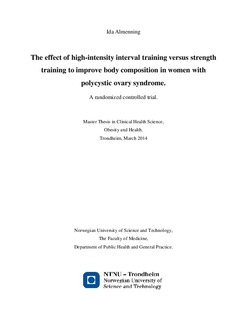The Effect of High-Intensity Interval Training Versus Strength Training to Improve Body Composition in Women With Polycystic Ovary Syndrome - A Randomized Controlled Trial
| dc.contributor.author | Almenning, Ida | |
| dc.date.accessioned | 2015-04-10T14:35:40Z | |
| dc.date.available | 2015-04-10T14:35:40Z | |
| dc.date.issued | 2014 | |
| dc.identifier.uri | http://hdl.handle.net/11250/281452 | |
| dc.description.abstract | Background: Polycystic ovary syndrome (PCOS) is a common endocrine disorder affecting 6-20% of reproductive-age women. Women with PCOS tend to accumulate more upper body fat, and the syndrome is often present with abdominal obesity and visceral adiposity which is further associated with metabolic – and cardiovascular complications. Despite well-established benefits of exercise and its recommendation in PCOS management, few randomized controlled trials have evaluated the benefits of exercise as the only intervention on body composition in women with PCOS. Objective: The aim of the present study was to investigate the effect of high-intensity interval training (HIT) and strength training (ST) versus control, on body composition in women with PCOS. Methods: We did a randomized controlled trial, including 31 previously sedentary women randomly assigned to one of three groups; High intensity interval training (HIT; n = 10), strength training (ST; n = 11) and control (CG; n = 10). At baseline and 10 weeks follow-up, body composition and anthropometrics was evaluated and compared between groups. Outcome measures: Body composition and visceral fat (VF), body weight, and waist circumference (WC). Results: Twenty-five women completed the study intervention and post-training testing (ST; n=8, HIT; n=8 and CG; n=9). Weight did not change in any group. There was a significant decrease in percentage fat mass (FM) after ST [EMM: -1.6, 95% CI: -2.5 to -0.7] and HIT [EMM: -0.9, 95% CI: -2.2 to -0.0], respectively. Fat-free mass (FFM) increased significantly after ST [EMM: 1.2, 95% CI: 0.4 – 2.1], but not after HIT [EMM: 0.4, 95% CI: -0.2 to 1.1]. There was no significant between-group differences in the change in percentage FM (p=0.54) and FFM (p=0.18). There was no changes in WC or VF within or between groups. Conclusion: These data indicates that in the absence of body weight changes, both ST and HIT have beneficial effect on body composition in women with PCOS. Percentage FM decreased significantly after both ST and HIT, and FFM increased significantly after ST. | nb_NO |
| dc.language.iso | eng | nb_NO |
| dc.publisher | NTNU | nb_NO |
| dc.subject | Polycystic ovary syndrome | nb_NO |
| dc.subject | exercise training | nb_NO |
| dc.subject | body composition | nb_NO |
| dc.subject | fat distribution | nb_NO |
| dc.subject | visceral fat | nb_NO |
| dc.subject | strength training | nb_NO |
| dc.subject | high-intensity interval training | nb_NO |
| dc.title | The Effect of High-Intensity Interval Training Versus Strength Training to Improve Body Composition in Women With Polycystic Ovary Syndrome - A Randomized Controlled Trial | nb_NO |
| dc.type | Master thesis | nb_NO |
| dc.subject.nsi | VDP::Medical disciplines: 700 | nb_NO |
